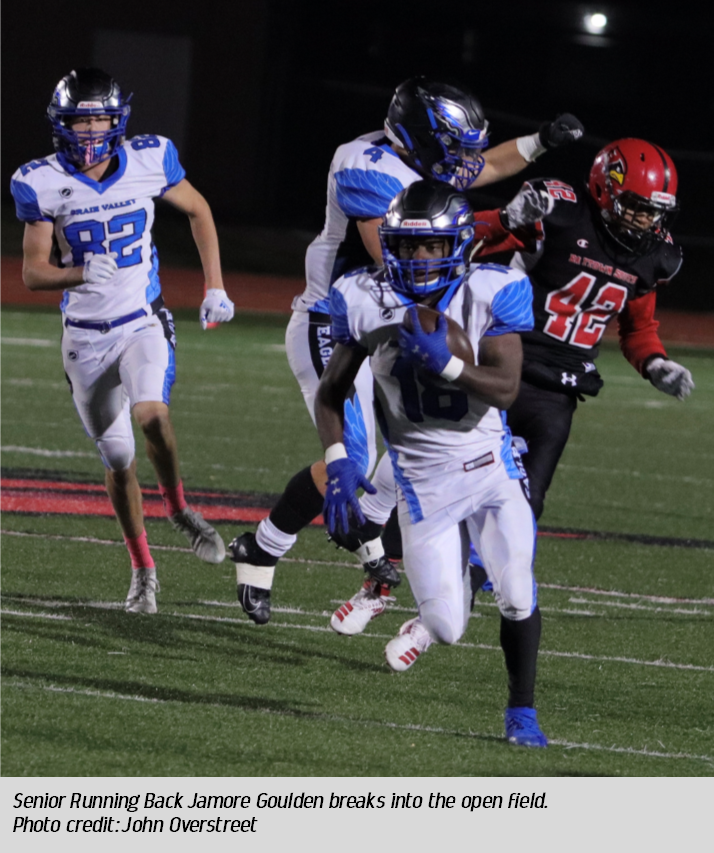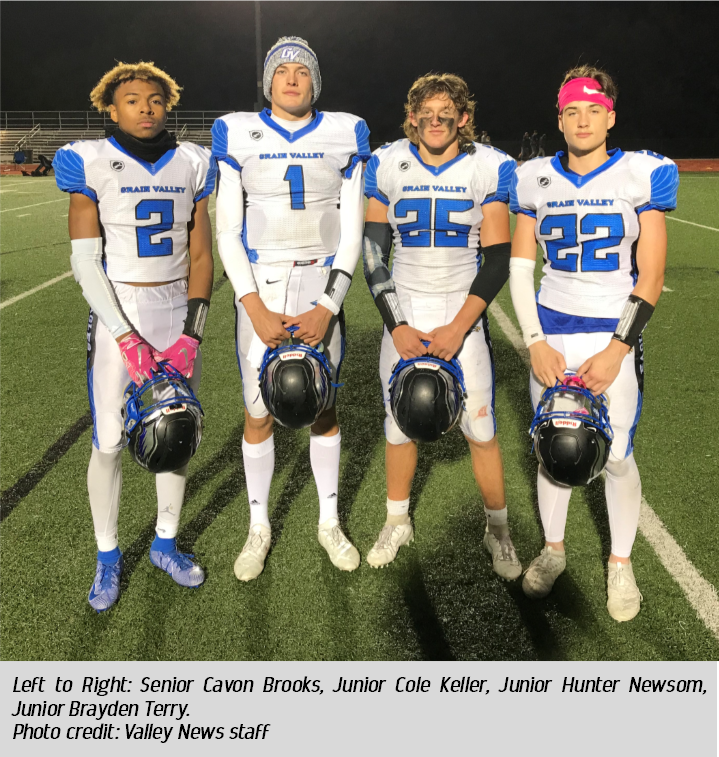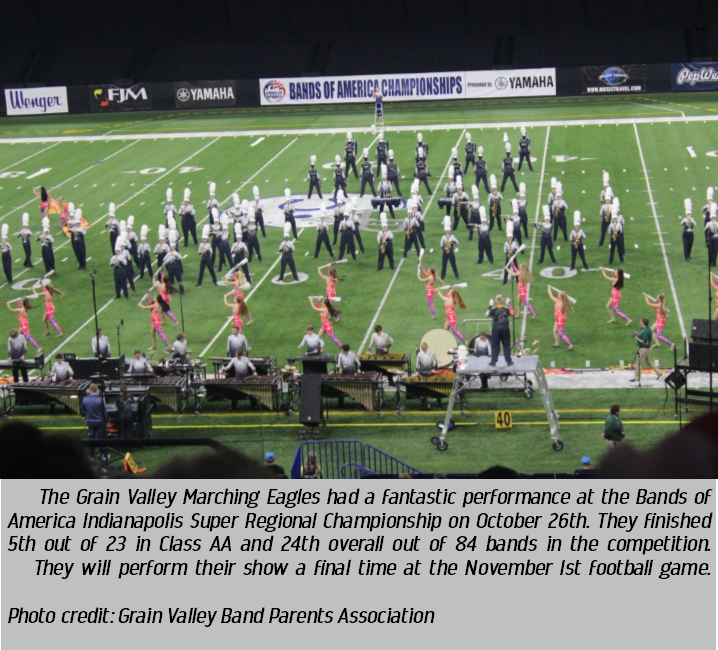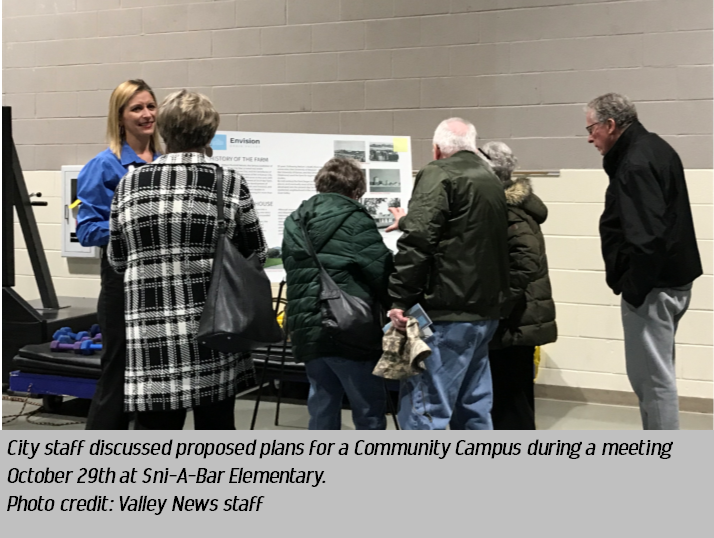|
|
by John Unrein Football is a game of adjustments. The coaching staff that seizes upon the opportunity to first modify strategy tends to reap the rewards. That was the case for the Grain Valley Eagles as they shut out the Raytown South Cardinals 37-0 on Friday, October 25th.
Grain Valley had only produced one touchdown by the end of the first quarter. Much of the Eagles offense centered around a four wide receiver set out of their spread offense. This left the edge of the Cardinals defense narrower and downhill runs like trap were not producing what they typically do through B gap. Head Coach David Allie introduced single and double tight end sets to widen Raytown South’s defensive front that yielded results on the ground for the Eagle’s rushing attack. “We had scouted them and how they would adjust to tight end sets. Introducing the tight end and later adding a fullback opened up trap and ISO runs for us,” Allie said. Eagles Running Back Jamore Goulden shouldered 16 carries for 73 yards and two touchdowns. The senior’s fortitude was front and center on several goal line and short yardage runs that yielded results as Goulden fought his way through contact while securing the football. Raytown South would introduce an eighth defender to the box during the second half. The addition of a Cardinal safety near the line of scrimmage opened two doors for the Eagles offensive attack. First, was single outside coverage on Grain Valley wide receivers. Senior Wide Receiver Gavin Oyler and Sophomore Wide Receiver Logan Pratt were able to garner separation from the coverage of Cardinal cornerbacks. Both challenged Raytown South’s single high safety with vertical and post routes that yielded completions against a Raytown South secondary that could not provide support over the top against multiple downfield threats. Oyler lead the Eagles with 58 receiving yards on four receptions. “We talked at halftime and said we have to execute better in the passing game. We wanted to take advantage of them having only one safety in the middle of the field at times. When we execute on offense, we are dangerous. When we don’t, we’re not as good as we could be,” Allie said. Second, was play action waggle with the quarterback boot. Junior Quarterback Cole Keller held the fake a count longer on the false handoff than he had in previous weeks, allowing the contain by the defensive end to crumble as Keller would only have to outrun one safety to the end zone. Keller did just that on two occasions. The Eagles signal caller would end up with 86 yards rushing on 9 carries and 2 touchdowns. Both rushing scores would come off play action waggle runs, including Keller diving into the end zone near the pilon with two minutes left in the second quarter. The Eagles would carry a 21-0 lead into halftime before they would go onto to establish a running clock near the eight minute mark of the fourth quarter following a successful 25 yard field goal attempt by Senior Kicker Jack Knust. Grain Valley’s defense would match the tenacity of its offense throughout the game. Eagles black shirt defenders would force five punts, two turnovers on downs, and four interceptions against an athletic Cardinals offense. Preserving the shutout through interceptions were Senior Defensive Back Cavon Brooks, Junior Defensive Back Brayden Terry, Junior Safety Cole Keller, and Junior Linebacker Hunter Newsom. Brooks was the first to pick off the opposition with 2:35 left in the first quarter. “I maintained backing up in my drop and stayed over the top. He threw it my way and I was able to secure the football,” Brooks said. Terry would provide the second interception for the Eagles with 1:12 left in the second quarter. “I could tell he (the wide receiver) hesitated to go outside and then went inside on a post. I was able to keep inside leverage and get the football,” Terry said. Keller would be next in the quartet of interceptions as time would expire in the first half. The Eagles would go to a prevent defense near the end of the half and Keller was inserted as a third safety with instructions to not let anyone behind him. “We estimated that they would throw the ball to their number one receiver (Carter Raevon) that late in the half. I was positioned over the top of him on that side of the field. The ball was thrown short and I picked it off,” Keller said. Newsom would shut down what little momentum Raytown South could build on a drive in the second half, with his 54 yard interception return down to the Cardinal’s 13 yard line. Newsom had faked a blitz on the down and retreated to the flat where he captured the Eagles fourth and final interception at the 9:52 mark of the fourth quarter. “We had been blitzing off the edge. Coach (Carpino) called a fake blitz, and I vacated to the flat where I looked the ball in for the interception,” Newsom said. Allie would credit defensive backs coach Dominic Giangrosso for placing members of the Eagles secondary in spots to be successful. Giangrosso would move safeties to landmarks in the secondary throughout the game, based on formation and tendencies that Raytown South’s offense was displaying. “First of all, hats off to their wide receiving core. Especially, number one (Carter Raevon). We did bracket him and make adjustments at halftime. We decided to rush only three down lineman and take away the hook to flat area. That helped us get our hands on the football defensively,” Allie said. The win moves Grain Valley to a record of 6-3 on the season. The Missouri State High School Activities Association computer formula for Class 4 District 7 football has awarded Grain Valley to host their next game on Friday, November 1st at Moody Murray Stadium against the same Raytown South Cardinals. The winner would go on to face the Grandview Bulldogs or Belton Pirates, who will also be in action that same date. The City of Grain Valley hosted a community meeting to discuss proposed site plans for a Community Campus at the former Sni-A-Bar Farms property on Tuesday, October 29th. The proposed Community Campus will move city services currently located just south of 1-70 on Buckner Tarsney Road further south to the historic Sni-A-Bar Farm property. The proposed campus includes a new city hall, police department, community center with indoor aquatics, and Mid-Continent Public Library branch. Approximately 200 residents attended the event.
City staff and representatives from Sapp Design Architects began the meeting with a presentation of the three proposed site plans and briefly touched on the timeline and approximate cost of the project, estimated at $37-41 million. A no tax bond issue is planned for April 2020 to fund the project, and $5-8 million in prospective partnership opportunities were mentioned as additional funding for the project. Residents shared feedback during the presentation through a mobile survey tool, which indicated over 2/3 of respondents were in favor of the project. Following the presentation, City staff and elected officials were stationed throughout the room to discuss plans and receive feedback from residents. Bonnie Darby and her husband Tom Darby have lived in Grain Valley for 40 years and came away from the presentation with differing opinions. Bonnie was receptive to the idea of a community campus and appreciated the concept of having the library, city services, and community center in one location. Tom was less enthusiastic and voiced a number of concerns, including the isolation of city services further south of the center of the city, concerns regarding the response time for police in a less central location, plans for Armstrong Park, and the lack of detail regarding funding available for maintenance of new facilities. “This seems like a fait accompli. We were presented their plans without opportunity to give voice or vote,” Tom said. Responding to this criticism, Mayor Todd emphasized this is just the first of several meetings and opportunities for the public to voice their opinion on the project, “This is a true democratic process. It will likely be on the ballot in April. Residents will have the chance to learn about the project and vote yes or no. If they vote no, it’s not going to happen. We’ll have more meetings and folks will continue to have opportunities to voice their opinions and shape the project,” Todd said. For more information on the project and proposed layouts discussed at the October 29th meeting, visit www.envisiongrainvalley.com. I wasn’t born here. I chose to move here. I’m often asked why and simply reply, “It was a God thing.” Although I’ve lived in the Kansas City area for almost two decades, I was born and raised in Miami, Florida. Miami is known as the land of sunshine, suntans, palm trees, and sandy beaches. My first experience with cold weather was not until 2001. It was quite the culture shock from living in the south.
You would think that, by now, I would be acclimated to the cold. I’m not. I’m not sure I ever will be. I’m not sure if it’s nature or nurture, but I’m just cold natured. Living down south, I never had to deal with cold weather, except when my father would crank down the A/C to 68. I vividly remember the first time I got really cold. During our first year in Kansas City, some new friends invited my wife and I down to the Plaza. They warned us, “dress warmly it’s going to be cold and we’ll be walking around.” My wife and I really thought we were prepared. We weren’t. We had never experienced truly cold weather and just didn’t understand how to dress for cold weather. That night on the Plaza, I noticed that everyone else was bundled up with appropriate winter clothing—having hats, gloves, and scarves. My wife and I had coats and gloves, but they were more for fashion than for freezers. What we wore were heavy winter clothes suitable for Florida, but not Kansas City! I still fondly remember my wife saying, “I fill wike my face id fwozen.” Apparently, so were her lips. At one point, in order to warm up, our hosts said, “Let’s stop in Barnes and Noble.” My wife excitedly replied, “Bawns en nobehl, I wuv bawns en nobehl.” Every year, it’s always the same. After the brutally hot summer, and the one week of fall-like temperatures, I pull out my winter clothing and wait. The first arctic blast always catches me by surprise. I step out of the front door and get assaulted by brutally cold temperatures driven by 40 mph winds. The cold blast shocks my system and sends a chill down my spine. I instinctively pull my jacket around me tighter and make sure my collar is up over my neck. “Man,” I complain, “It’s cold.” My wife opens her weather app and says “It’s only 42 degrees.” “I know,” I say agreeingly, “It’s freezing!” adding, “It’s gonna be a long winter.” I think to myself. I’m a winter weather wimp. Even so, I do know how to adequately prepare for the season. I guess you could say I’ve learned a few things—much of it the hard way. “Wow, you’re dressed up today” a friend says. I just smile and say warmly, “thanks.” Actually, my attire has more to do with the weather than anything else. I’ve found that a simple way to overcome “cool” temps, and not look overly wimpy, is by wearing a sports jacket. A sports jacket over a tee-shirt makes anybody look dressed up. In addition, the great thing about a sports jacket is that they have lots of pockets. That’s great because I carry lots of stuff. I like to carry my phone, keys, pens, wallet, gum, breath mints, lip balm, headphones, and the 20 bucks my wife gives me each week. The challenge is trying to remember to remove them from my pockets at the end of the day and transfer them to the next day’s wardrobe. By personal experience, I’ve learned that, for me, there are two major keys to keeping warm. The first key is layers. This is related to the quality/quantity debate. For me, it’s not about the big coat on the outside, but the seven layers on the inside. Okay, maybe I’m exaggerating a little bit, but I’m sold on layering. I love my UnderArmor. It feels great and adds a wonderful layer under my clothes without adding 3 inches to my frame. The other key to keeping warm is my extremities. If I can keep my feet and hands warm, I can generally stay warm. For my hands, I have several different kinds of gloves. When it gets to about 40, I have a light pair of gloves. When it drops below 40, I have a thicker pair. When it drops below zero, I’m not embarrassed to wear both—or even put “Hot Hands” inside them. I’ve also learned that I need to keep my feet warm. At times, I have been known to double up my socks. I even enjoy sleeping with slippy socks. Over the years, I’ve learned to tuck my pajama pants into them to keep my pjs from riding up. Currently, in my spare time, I’m looking to invent a pajama pant/sock combination that uses Velcro technology. If you see something similar on Shark Tank, they stole it from me. Being a runner gets really complicated in the winter. The basic rule of thumb for winter running is that your body will warm up 20 degrees—so don’t overdress. It’s a lesson I’m still trying to learn. It’s important to remember that what you start with is what you’ll end with. A couple of times I’ve run races and had to remove my beanie and/or gloves and then try to cram them in my pockets while running. I’ve tried to force my body to get used to the cold. The coldest I’ve ever been was on a New Year’s Day run several years ago. It was called the, “Hangover Half.” As a teetotaler, I felt I had a chance of finishing near the top. Unfortunately, it was so cold that they cancelled the official race out of concern for the runners. But, as a consolation, they decided to offer a “fun run” and give away prizes. I chose to run. I was properly attired with more layers than a lasagna and honestly, I was not cold during the run. But, since I had a hood and mask (which I referred to as my ninja mask), the warm air from my body would fog up my glasses impairing my vision. What’s worse is, I could not simply wipe them off because of the large gloves on my hand. In the end, I was happy that I was able to face the brutally cold temperatures and run. After two decades of the cold, I’m still not acclimated. However, I have learned a few tricks on how to deal with the cold. And, one of the cool things is that, every fall, when I pull out my winter weather gear, I always find lots of cool stuff like lip balm, mints, and even a twenty-dollar bill! Wayne Geiger is the Pastor of First Baptist Grain Valley, an Adjunct Associate Professor of Speech, and freelance writer. He can be reached at waynegeiger.com. As we head into the holiday season, your Community Foundation is reminded of the many ways that philanthropy strengthens our community. Just a few weeks ago, Truman Heartland celebrated the 24th Annual Toast to Our Towns Gala, presented by Speaks Chapels. With more than 700 attendees, it was a great celebration of the many generous individuals and organizations here in Eastern Jackson County.
Tom and Carman Duvall were recognized as the Heartland Humanitarians of the Year, GEHA as the Heartland Corporate Citizen of the Year, Drumm Farm Center for Children received the Heartland Service Award and George N. Koepp was awarded the Dr. Paul M. Thomson Professional Advisor Award. Together, with seven local mayors, Truman Heartland awarded the Citizens of the Year awards to individuals and families who exemplify what it means to be a community servant and philanthropist. The success of this event was due to supporters like Gala Committee chair Judy Forrester, who has served as the Gala Committee chair for eight of her nine years on the Truman Heartland Board. In those years, Judy’s leadership has helped raise nearly $2 million for the community. We are incredibly grateful for Judy, her vice chair Candy White and their dynamic Gala Committee, Brad Speaks who chaired the Gala Sponsorship Committee and all of the individuals and business whose generosity helped make this year’s event an evening to remember. At the event we shared that your Community Foundation is on track to have another outstanding year in grantmaking and scholarships. We are on pace to exceed last year’s total of $4.4 million. And we continue to see generous giving to funds at the Foundation, with this year’s contributions on pace to exceed last year’s record total of $7.2 million. We also shared some exciting news about our new community initiative at the Gala. Last month the Truman Heartland Board voted to launch our Job Skills Training initiative and create a collaborative partnership with four organizations working in this arena: Community Services League, Mid-Continent Public Library, University of Central Missouri and Herndon Career Center. Our common goal is to provide job skills training to low-income working adults in the community. We believe that these organizations bring unique assets to the table and by working together, we can successfully equip families to work their way out of poverty. We are deeply grateful for the opportunity to celebrate philanthropy in Eastern Jackson County and want to thank the many people who support our work in our community. Stay tuned for updates as we move forward with our new Job Skills Training initiative. Phil Hanson is the President and CEO of Truman Heartland Community Foundation. Truman Heartland Community Foundation (THCF) is a 501(c)(3) public charity committed to improving the communities in and around Eastern Jackson County through cooperation with community members and donors. For more information on charitable giving, visit www.thcf.org or call Truman Heartland at 816.836.8189. by Kimberly Wendschlag Happy Fall! Whew! We all survived the heat of the summer and went briskly right into fall. Have you turned your heat on yet? We tried our best to hold out, but brrrrrr! Those early mornings are a bit chilly…even with my fuzzy blanket. This is the season that we bring out the crock pots, the tea kettles, the hot chocolate, the soups, stews and all the pumpkin spice one can find.
Along with all of these warm, cozy, comfort items comes less activity for many. Less busyness (except for you mama’s running your kiddos to all of their activities. I see you! ) Less heat, less outdoor work and my favorite, less sweating! The soups begin to replace the fruits. The hot chocolate starts to replace a glass of ice water, and warm muffins take the place of a good, cold piece of fruit. We are so fortunate to live in the country that we do. We have so many choices of foods to consume. Watermelon, strawberries, cucumbers, cantaloupe and oranges, oh my! Did you know that each of these have a water content of at least 90% or above? Not only are they delicious but they are also a great source of H2O. For example, 1 cup of watermelon contains over one half of a cup of water. You are killing 2 birds with one stone! Healthy fruit + water intake = Hydration! The human body is made up of approximately 60% water. Most of that water is contained in our cells with lean tissue holding more water than fatty tissue. On average, most of us have been told to drink 8 glasses of 8 ounces of water daily to maintain a good hydration level. This is a terrific place to begin and to strive for. Another way to balance your water intake is to strive to drink about half of your body weight in ounces of water daily. For example, a person weighing 200 pounds should do their best to get about 100 ounces of water into their diet daily. This water can come from multiple sources, such as fruits, vegetables, unsweetened tea, water, black coffee and even skim milk. I hear you. “There’s no way my body needs that much water.” “How in the world am I going to do my job? I don’t have time to be in the restroom that often.” I hear that one a lot! Friends, you don’t have the time NOT to. Unless, that is, you are a frog. Ribbit. Did you know that frogs, some types of lizards, and a few other species do not drink water? Nope. They soak it all in through their skin. They do not swallow water. They do not lick up water. They do not even choose food that has a high water content. They have the life. Eat what they want, do what they want, then just soak up the liquid and live happily ever after. Can you imagine? Soaking in the jacuzzi for days on end. Saturate ourselves with a warm bath and forget the H2O ounce counting once and for all. Oh, how heavenly that would be. Much less stressful for sure. We must step back into reality and realize that we aren’t frogs, or sand gazelles, camels or woodrats. We are humans and we must drink water. We can survive 3 weeks without food, but only around 3 days without water. On any given day a person typically loses between 4 and 9 cups of water. We lose water through breathing, sweating and restroom elimination. If we aren’t consuming enough water to accommodate this loss, we become dehydrated. Dehydration can result in achy joints, digestive problems, constipation, increased blood pressure and an overly acidic stomach. Without drinking enough water our body also has a difficult time ridding unwanted fat. It’s simply a vicious cycle. Let’s change the way we think about water! Here are a few easy steps to take to help you get your daily water consumption in: Drink before you eat; Carry around a large water bottle; Use an app (Yes…there’s an app for that); Have an accountability partner; Remember, WATER is LIFE. Kim is a business owner in Grain Valley, as a Health and Wellness Advocate with Plexus Worldwide. www.plexusslim.com/kimberlywendschlag by Marcia Napier, Grain Valley Historical Society Known now as Acquaint Gathering, the oldest continuously used building in Grain Valley was dedicated as a church in 1889. The original structure was erected on lots 3 and 4 in Finnell’s Addition. The land was purchased from Mary Wright and her husband J. B. Keshlear. The first church trustees, Joseph R Hudson, David T. Johnson and W. L Williams purchased the lots for $60 and $75 respectively. They were on Capelle Street just south of the Grain Valley School. The Methodist Episcopal Church South began in 1888, and was the third church building in Grain Valley. The Christian Church was established in 1883, and the First Baptist Church was established in 1884. Lumber for the church was hauled to the site from a nearby lumber mill by William Armstrong. With very limited funds, only the main room or sanctuary was able to be enclosed and furnished with simple benches and a pulpit. First called Pleasant Valley Chapel, Perdee Chapel on Moreland School Road in Stony Point, was sold and the proceeds were used to finish the walls and plank floor and equip the new church. The church building remained unchanged for nearly 60 years. By 1948 the growing little church was in need of Sunday School rooms, a kitchen, a dining room and an attic for future classrooms. Then in 1962 a legacy of $6,300 was received which made it possible for the church to purchase a new heating system (to replace the huge jacketed stove in the back corner) and a bathroom. Years later additional classrooms were completed upstairs, and the entire interior got a facelift. With limited space and even more limited parking, the congregation had to seek land for a new church. In 2007 Faith United Methodist Church relocated to Eagles Parkway, but the building is still very much in use. The owners of Acquaint Gathering have kept the integrity of the building, as they turned it into a facility for special events. They provide a great venue for weddings, anniversaries, birthday parties and family reunions. They even hosted a prom there for a small Christian school. And for the past two years, Faith United Methodist has filled the old church for their Ash Wednesday Service. The roots run deep in this old building. The Grain Valley Historical Society Museum is located at 506 South Main Street and online at www.grainvalleyhistory.com. Known now as Acquaint Gathering, the oldest continuously used building in Grain Valley was dedicated as a church in 1889. Photo credit: Diana Luppens, Switch Focus Studios
The Missouri Department of Transportation (MoDOT) will close the entrance to Route AA at Eastbound U.S. 50 Highway from Monday, November 4th through Wednesday, December 4th for new concrete pavement construction.
MoDOT has a signed state detour. Drivers are encouraged to plan and find an alternative route that works best for their needs. All work is weather dependent. Motorists are reminded to slow down and pay attention while driving in work zones. Not all work zones look alike. Work zones can be moving operations, such as striping, patching or mowing. They can also be short term, temporary lane closures to make quick repairs or remove debris from the roadway. It was business as usual at the October 28th Board of Aldermen meeting, save for the absence of City Administrator Ryan Hunt, who has worked with the City since 2009, becoming City Administrator in 2015.
Hunt requested leave beginning September 29th, which the Board of Aldermen granted during an October 3rd closed session. The Board voted to fire Hunt last Thursday, October 24th in a closed special meeting. Hunt’s last day was Friday, October 25th. Mayor Todd declined to comment further, stating it was a personnel matter. Hunt did not respond to request for comment. “I appreciate his service to the City. He helped us through the big 1-70 project and served the City for over 10 years,” Mayor Mike Todd said. “The good thing is, with the staff we have, we have a number of qualified folks who could step into that position. We’re in good shape.” Todd mentioned the search for a replacement would likely not begin until after the first of the year. Announced briefly during staff introductions at the Community Campus meeting on Tuesday, October 29th at Sni-A-Bar Elementary, Ken Murphy, former Deputy Administrator, was introduced as Acting City Administrator. Murphy echoed Mayor Todd’s confidence that the absence of Hunt would not affect projects like the proposed Community Campus. “Our internal lead on the project has been Theresa Osenbaugh (Assistant City Administrator). She and I have been the main contacts working with the design team, so we haven’t had to make any detours along the way,” Murphy said. The October 28th Board of Aldermen meeting included a vote approving an ordinance to call an election in the City on April 7, 2020. The City also extended the current agreement for one year with the Oak Grove Animal Hospital to provide boarding and animal care services for animals taken into custody by the Grain Valley Animal Control Officer. In the first of two town hall events hosted at the Grain Valley Community Center, Missouri District 32 Representative Jeff Coleman addressed resident concerns on October 22nd regarding Jackson County tax assessments.
Approximately 25 residents attended the initial town hall, which focused heavily on County tax assessments and touched briefly on Coleman’s plans for the upcoming 2020 legislative session. Coleman represents areas in north Blue Springs, most of Grain Valley and Oak Grove. Coleman was appointed over the summer to a special committee charged with looking at concerns of homeowners across the state regarding the process of assessing property tax values and fairness of the process. Hearings were held in Kansas City, St. Louis, and Jefferson City. Coleman explained the committee has one meeting remaining to come up with recommendations to resolve issues property owners are facing. An issue raised during the meeting was the seemingly haphazard way in which increases occurred and the burden placed on the property owner to appeal decisions. Coleman referenced 74,311 property owners whose properties all increased by 14.9%. “The assessor is required at a 15% increase or more to go out and do a physical inspection. So, when you put 74,311 folks at 14.9%, which is the maximum you can do without having to go out and do a physical assessment, it starts to make you wonder what’s involved. We’re trying to unpack all of this and understand what could have been done differently,” Coleman said. “The onus is on the property owner to disprove the assessment. We have to come up with evidence to disprove the County’s assessment and not everyone has the wherewithal to do that. Especially in lower income areas, and that’s where a lot of those 14.9% increases were. How are these folks supposed to know the process.” Coleman cites funding issues and incompetency as major reasons behind the issues faced in Jackson County. “We are really behind the eight ball in reference to the funding we have for the County Assessment department and the tools the County needs, because the County Assessor doesn’t have the funding to buy the right tools. Because of that , there is zero data for them (the County) to show why they put their assessment where they have it,” Coleman said. “Thanks to local reporting (referring to KCTV Channel 5 reporting) and Sunshine Law requests, we now have access to emails that show a real incompetency in what they did and how they got there.” Reached for comment, Marshanna Smith, spokesperson for the Jackson County Executive’s Office, emphasized the County Assessor is bound by state laws and rules when setting values and funding cuts have impacted the department’s ability to fulfill the state-mandated reassessment process. “The County is sympathetic to the concerns raised by residents during this year’s reassessment and we have worked very hard to address them, while maintaining an equitable and accurate process. For example, contrary to many media reports, more than 1,600 homeowners in the 64029 zip code will pay less in taxes this year than last year. When setting values, the assessor is required by state laws and rules designed to ensure assessments are as uniform as possible. As a result, properties must be placed on the tax rolls at their true market value. Market value is the price the property would bring when offered for sale by a person who is willing but not obligated to sell it, and is bought by a person who is willing to purchase it but who is not forced to do so. Any deviation from this mandate would be a violation of state law. In addition, if any taxpayer believes their property’s value is inaccurate, they have multiple options. First, Jackson County offers all property owners an opportunity for an informal review by our Assessment Department, where the property owner can provide additional information that may not have been available to our staff at the time they first determined the property’s value. Second, a property owner can appeal their valuation to the Board of Equalization. Finally, if a property owner is still not satisfied, they can ask the State Tax Commission to hear their case,” Smith said. “The County is hopeful that Rep. Coleman and colleagues in the state legislature will address residents’ concerns by passing meaningful reforms in Jefferson City. Such changes must include providing adequate funding to counties across the state so that assessors can properly fulfill the state-mandated reassessment process. Unfortunately, over the last 10 years, the state has cut this funding in half and are now only providing a reimbursement of $3 per parcel to counties. We are also hopeful that the Missouri Legislature will not only protect the “circuit breaker” tax credit protections currently in place for senior citizens and persons with disabilities, but will also look at increasing and expanding this protection.” Coleman emphasized that the likelihood of a solution coming before the end of the calendar year was slim, but that multiple legislators would likely be proposing bills in the 2020 session to address property tax assessment issues. Coleman touched on a proposal he is considering that is similar in scope to California’s Proposition 13, which when passed in 1978 brought sweeping changes to the states property tax system. Primarily, Proposition 13 capped tax rates at one percent of full cash value at the time of acquisition, transferred responsibility for allocating property tax to the state, and replaced annual assessments with reassessment upon change of ownership. Outside of property tax issues, Coleman is interested in focusing on disability and Medicaid issues as well as the foster care system in the coming session. In addition, Coleman stated that transportation must be a priority for the state. “Someone’s going to have to stick their neck out and raise the tax two cents or something similar. I don’t think there’s any support for toll roads; I think it’s going to have to be a tax. I think you’re going to see the legislature push the issue out to voters,” Coleman said. A year in to his tenure, Coleman reflected on the highs and lows of the job. “The most frustrating thing so far is that I hate that every two years you have to re-up, because it becomes all about getting back into office and it shouldn’t be like that. That’s been the most frustrating thing to me. The most positive thing so far is that I got one bill and two amendments through in my first session and was elected Vice Chair of Economic Development. Those are nice accomplishments for a first year member, but I’m really most proud when I’m able to help folks with issues that affect their lives,” Coleman said. “I had a single mom email me and her children had been covered by the PACE program for insurance. She sent the paperwork in to renew coverage but the Division of Family Services claimed they did not receive it, dropping her children’s coverage. I told her, ‘I can’t promise anything, as I’ve never done this before, but I’m going to call and see what I can come up with.’ I left a message with DFS and the mother called in the tears the next day letting me know that her coverage had been restored.” “That means more to me than anything I’ve done in the legislature, because I was able to help somebody with something they were struggling with and unable to get through. Those are the kinds of things that I hope will happen more. I want people to call me. I want people to get involved.” Representative Jeff Coleman can be reached at 573-751-1487 and [email protected]. |
Categories
All
Archives
July 2024
|
Grain Valley NewsGrain Valley News is a free community news source published weekly online. |
Contact Us |










 RSS Feed
RSS Feed
